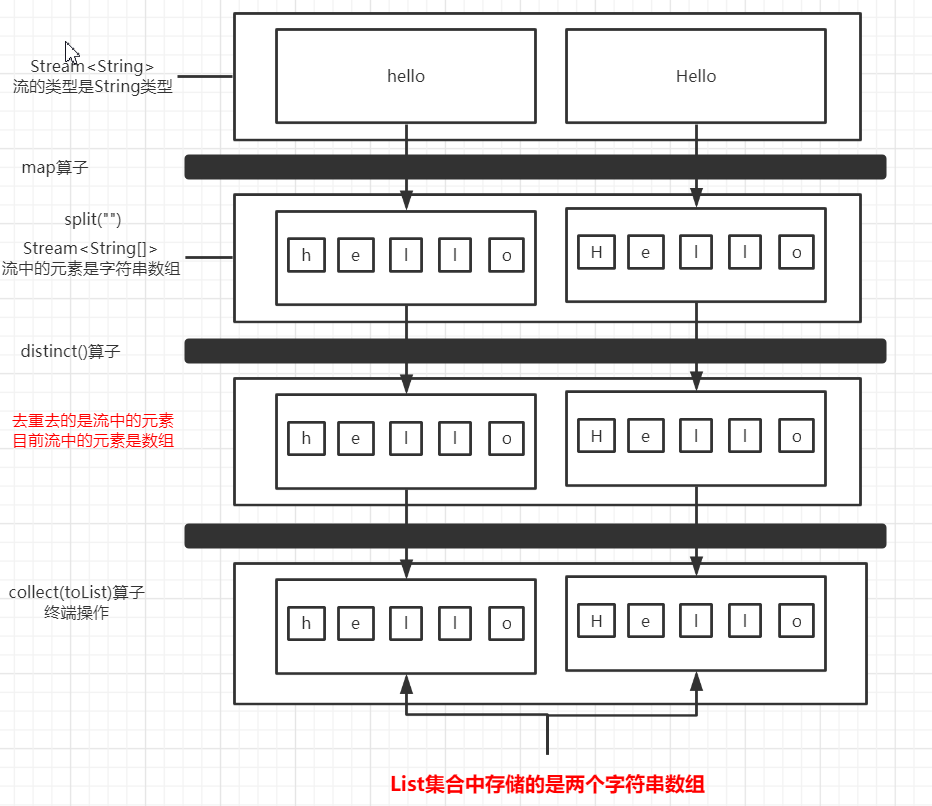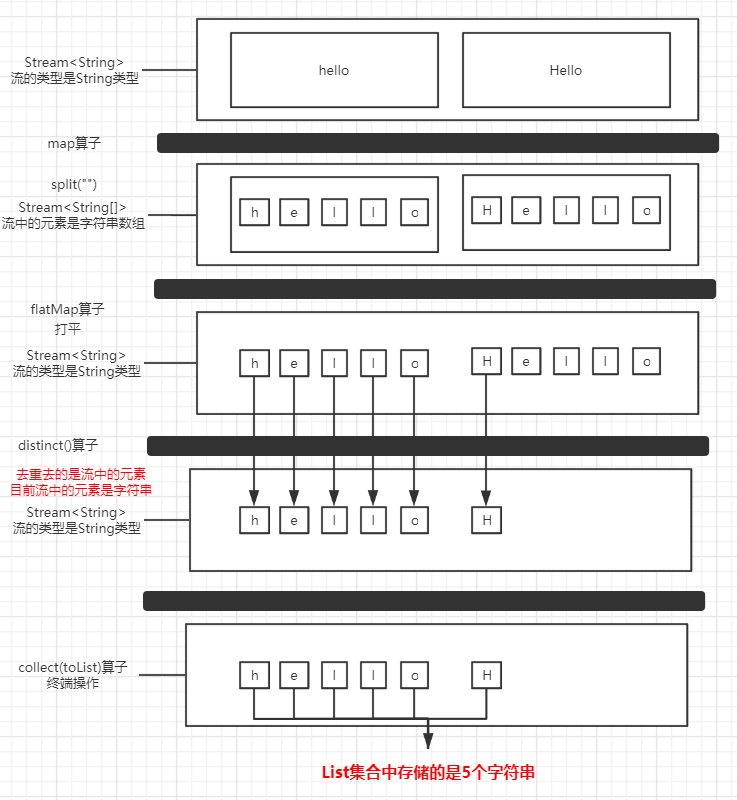map算子和flatMap算子
map和flatMap都是映射(转换),那么他们之间究竟有什么区别呢?
1.我们先简单了解下map算子:
@org.junit.Test
public void test1(){
List<String> words = Arrays.asList("hello","world");
words.stream()
.map(String::length) //使用了方法引用,将String类型转换为int类型
.forEach(System.out::println);
}
//输出:5 5
map是流的中间操作,
传入一个Function函数式接口,返回一个流。关于函数式接口和lambda表达式可以看我之前的随笔。
2.再看个例子,来简单了解下两者间的区别,先着重思考一下下面的案例用map会有什么问题?
需求:传入一个集合 list = Arrays.asList("hello","Hello")
要求:输出:h,e,l,o,H (单词里面的每一个字母去重 ,并且进行打印)
@org.junit.Test
public void test2(){ //错误演示
List<String> list = Arrays.asList("hello","Hello");//h,e,l,o,H
list.stream()
.map(m->m.split(""))
.distinct()
.collect(toList())
.stream()
.forEach(System.out::println);
}
那么输出结果符合我们的需求吗?
//输出结果:这俩行是个什么鬼?
[Ljava.lang.String;@51e2adc7
[Ljava.lang.String;@1a8a8f7c
这显然不符合我们的要求,那究竟是哪里出错了呢?我们一步一步分析一下:
1.Stream
2.Stream<String[]> mapRDD= baseRDD.map(w->w.split("")); 调用map算子,转换
3.Stream<String[]> distinctRDD= mapRDD.distinct(); 调用distinct算子,去重
4.List<String[]> collectRDD = distinctRDD.collect(toList()); 流转换为集合,最后输出
我们一步一步分析下来,看起来是不是还是没问题呢?接下来让我们再改写一下:
@org.junit.Test
public void test3(){
List<String> words = Arrays.asList("hello","Hello");//h,e,l,o,H
Stream<String[]> mapRDD = words.stream()
.map(word->word.split(""));
mapRDD.map(Arrays::stream)
.distinct()
.collect(toList())
.stream()
.forEach(System.out::println);
}
//输出:这又是个什么鬼???是不是越来越迷糊了,不要着急
java.util.stream.ReferencePipeline$Head@2353b3e6
java.util.stream.ReferencePipeline$Head@631330c
再来一步一步分析一下:
Stream<String[]> map1RDD = words.stream().map(word->word.split("")); 转换
Stream<Stream
Stream<Stream
List<Stream
这里我们需要注意的是:map转化(输入一个类型,返回另外一个类型)
输入类型的值(值的类型是上一个数据集的泛型)
输出数据的类型会作为下一个数据集的泛型
还是不理解?没关系,等会我们通过图来深刻理解一下。
那flatMap算子呢?
@org.junit.Test
public void test4(){
List<String> words = Arrays.asList("hello","Hello");//h,e,l,o,H
words.stream()
.map(word->word.split(""))
.flatMap(d->{
Stream<String> stream = Arrays.stream(d);
return Arrays.stream(d);
})
.distinct()
.forEach(System.out::println);
}
//输出
heloH
居然成功实现了需求,这两者究竟有什么区别呢?我们通过图画来更加生动形象的了解下(画图不易,值得一赞)

对比一下flatMap算子:

这样就一目了然了!!!
总结一下:
map算子:map返回值类型就是新的数据集的泛型
flatMap算子: flatMap算子返回类型就是新的数据集的类型
最后再看个案例:
需求:输入:【1,2,3】【3,4】
输出:【(1,3),(1,4),(2,3),(2,4),(3,3),(3,4)】
@org.junit.Test
public void test7(){
//集合(.stream())
List<Integer> number1 = Arrays.asList(1,2,3);
List<Integer> number2 = Arrays.asList(4,5);
/**
* 倒着推理一下 :
* 最终的结果(终端): List<int[]>
* 终端操作的上一个操作:Stream<int[]>
*
*/
List<int[]> pairs = number1.stream()
.flatMap(i->{
// Stream<int[]> stream =
// number2.stream().map(j->new int[]{i,j});
return number2.stream().map(j->new int[]{i,j});
})
.collect(toList());
Stream<int[]> intArrayRDD = pairs.stream();
intArrayRDD.forEach(arr->{
for(int i : arr){
System.out.print(i+" ");
}
System.out.println();
});
}//OK
至此,map算子和flatMap算子就介绍完毕了!